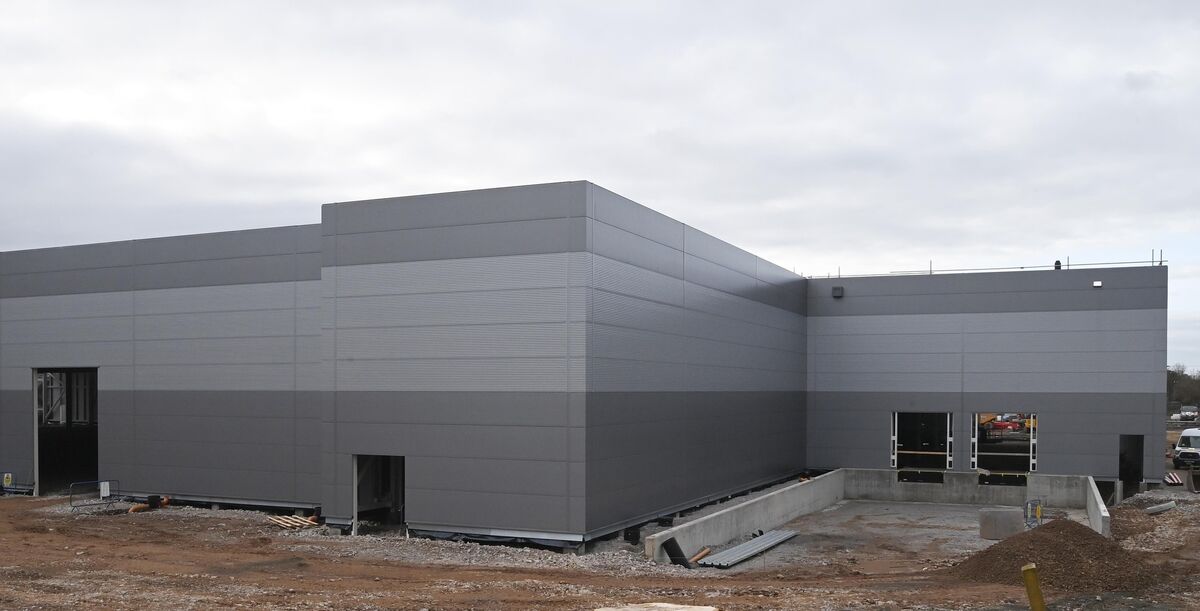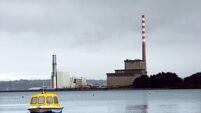They are large and cold, soulless and bland — yet ironically provoke an emotive reaction that ensures they usurp as much energy in the political cycle as any perennial issue.
What are we to do with data centres? Nobody seems to know.
Government figures seem to think the problem over their ever-increasing electricity consumption is overblown, opposition figures insist they have become an urgent issue, while environmental experts and economists clash over the best national strategy to take to manage the burgeoning beast.
According to figures from the Central Statistics Office (CSO), 18% of metered electricity in 2022 was used by data centres, the same percentage as urban homes.
Rural homes used 10% of all metered electricity in 2022.
Data centre electricity usage jumped by more than 30% in 2022 compared to the previous year. The increase between January to March 2015 and October to December 2022 was 400%.

There are around 70 data centres in operation in Ireland, mainly around Dublin, with a further 30 in planning. Around 2.2m homes use metered electricity, according to the CSO.
Considering that electricity consumption from data centres around the world is 1% compared to Ireland’s 18%, it is not unreasonable for the lay eyes and ears to look for an explanation and reassurance around their mammoth demands here.
Last year, Eirgrid ruled out new data centres in and around Dublin until 2028, while the Commission for the Regulation of Utilities (CRU) said in late 2021 that it would impose a moratorium on new ones if it deemed necessary to do so.
It is not just the energy consumption they use, but the emissions they produce that have many environmental experts worried.
Taoiseach Leo Varadkar said this week that data centres are important for the economy as 100,000 people work in the tech sector across the country.
“They might not work in data centres but their jobs are dependent on data centres, and the companies that require them pay billions of euro in tax in Ireland, which we use to pay for healthcare, housing, education and other things. We have to make sure that is part of the debate.
“If we had an open and honest debate about data centres, we would know, for example, that Zoom and Webex, technologies that enable remote working, which is so good for family life, require data centres. We would know, for example, that financial information, making electronic payments, internet banking and other services we use every day require digitisation.
"We would know, for example, that increasingly, we are going to need data for medicine because more and more often, scans are done digitally and samples taken go to the path lab and are examined individually,” he said.
Electricity-related carbon emissions actually went down last year, not up, he added.
As ever, context around political claims is needed.
According to the Environmental Protection Agency (EPA), Ireland is way off its emissions targets for 2030.

The country will achieve a reduction of 29% in greenhouse gas emissions by 2030 compared to a target of 51%, with almost all sectors on a trajectory to exceed their national sectoral emissions ceilings for 2025 and 2030, including agriculture, transport, industry, and crucially in this case, electricity.
Ireland’s carbon budgets, which allocate emissions ceilings to the likes of motorists, households, farmers, businesses, and industry in five-year cycles, aim to reduce emissions by 4.8% per annum from 2021 to 2025 under the first block, while the 2026-2030 budget will increase that annual reduction target to 8.3%.
The updated Climate Action Plan was approved by Government in December, and provides progress on Ireland’s climate action, as well as reporting on the progress made in meeting a 51% reduction in emissions by 2030, and climate neutrality by 2050.
Paul Deane, senior research fellow at MaREI, the Science Foundation Ireland (SFI) research centre for energy, climate, and marine at University College Cork (UCC), said claims that data centre emissions are overblown and relatively minor in the greater scheme of things is misleading.
“Everything is relatively small across the full economy.
But if we break it down to the power sector emissions and pollution, data centres now are responsible for just under a fifth. That is a lot.
“We have gone through one of the worst energy crises in Europe in the last 40 years, yet Ireland is one of the few countries in Europe to actually increase its electricity consumption during the energy crisis.
“This was at a time when we were encouraging householders and businesses and firms to reduce their energy use. But at the same time, we have an industrial policy in Ireland that needs a significant increase in electricity consumption.
“We saw the EPA projections last week, that the electricity sector is going to be really difficult to decarbonise.
"We have to acknowledge the incredible benefits that data centres bring into our lives in terms of remote working, and all the fun stuff with our mobile phones, and all this economic importance that they bring to Ireland.
"But at a political level, we need to make a choice — do we want to increase our industrial growth or do we want to reduce our emissions?
“Are we prioritising emissions reduction or economic growth? The figures here are pointing towards economic growth, which is leading to a significant pollution problem. It’s a difficult political decision,” he said.
The benefits of data centres and how digitisation has improved lives are the lines that Government fig
ures are taking since the CSO figures came out — “you can’t have it both ways” is ostensibly the rebuttal to those calling for draconian crackdowns on data centres.
What do data centres actually do?
Influential tech industry news website TechTarget.com defines them as “a facility composed of networked computers, storage systems and computing infrastructure that organisations use to assemble, process, store and disseminate large amounts of data”.
A business typically relies heavily on the applications, services and data contained within a data centre, making it a critical asset for everyday operations, TechTarget.com adds.
For an everyday citizen, all the shows we love on streaming apps, all the messages and memes and family pictures stored on our phones, all the documents we make for work, all the apps we use to connect our smart devices, it’s all connected by data centres and the heavy lifting to keep everything running smoothly.
For businesses, they are crucial for everyday systems, invaluable data backup, management, inventories, and other essentials.
For proponents of data centres, the benefit they bring to all our lives is why they accuse critics of wanting their cake and eating it.
That is a red herring, according to naysayers — it’s not the data centres themselves they object to, but the fact that Ireland seems to do much of the heavy lifting for much of the world, proportionate to its size. It is simply an unsustainable trajectory upwards if other nations don’t share the load, they say.
Then there is the problem of so-called “dark data”.
If this was to be tackled, the power usage and emissions could be dramatically curtailed, according to the likes of Professors Tom Jackson and Ian Hodgkinson of Loughborough University.
Writing for the World Economic Forum, the professors said that dark data — which is the likes of documents and pictures and clips we store in our files and never use again — is a significant problem.
More than half of the digital data firms generate is collected, processed and stored for single-use purposes. Often, it is never re-used.
"This could be your multiple near-identical images held on Google Photos or iCloud, a business’s outdated spreadsheets that will never be used again, or data from the Internet of Things sensors that have no purpose.
“This “dark data” is anchored to the real world by the energy it requires. Even data that is stored and never used again takes up space on servers — typically huge banks of computers in warehouses. Those computers and those warehouses all use lots of electricity,” they wrote.
While most climate change activists are focused on limiting emissions from motoring, flying, and energy, the processing of digital data is already comparable to these sectors, they said.
It is still growing, they added.
“In 2020, digitisation was purported to generate 4% of global greenhouse gas emissions. Production of digital data is increasing fast — this year the world is expected to generate 97 zettabytes (that is: 97 trillion gigabytes) of data. By 2025, it could almost double to 181 zettabytes.
"It is therefore surprising that little policy attention has been placed on reducing the digital carbon footprint of organisations,” they wrote.
For context, aviation generates around 2.5% of greenhouse gas emissions every year and is the target of much ire from environmental activists for the perceived folly of how easy it is to fly.
Digital decarbonisation
The professors suggest the idea of “digital decarbonisation”.
“By this, we don’t mean using phones, computers, sensors and other digital technologies to reduce an organisation’s carbon footprint.
"Rather, we are referring to reducing the carbon footprint of digital data itself. It is key to recognise that digitisation is not itself an environmental issue, but there are huge environmental impacts that depend on how we use digital processes in daily workplace activities.
“Using our calculations, a typical data-driven business such as insurance, retail or banking, with 100 employees, might generate 2,983 gigabytes of dark data a day.
"If they were to keep that data for a year, that data would have a similar carbon footprint to flying six times from London to New York.
"Currently, companies produce 1,300,000,000 gigabytes of dark data a day — that’s 3,023,255 flights from London to New York,” they wrote.
“The rapid growth of dark data raises significant questions about the efficiency of current digital practices.
"In a study recently published in the Journal of Business Strategy, we identified ways to help organisations reuse digital data, and highlight pathways for organisations to follow when collecting, processing and storing new digital data.
“We hope this can reduce dark data production and contribute to the digital decarbonisation movement, which we will all need to engage with if net zero is to be realised.
“You can even make a start yourself by deciding which photos and videos you no longer need. Every file stored on the Apple iCloud or Google Photos adds to your digital carbon footprint.”

Unlimited access. Half the price.
Try unlimited access from only €1.50 a week
Already a subscriber? Sign in
CLIMATE & SUSTAINABILITY HUB
CONNECT WITH US TODAY
Be the first to know the latest news and updates














